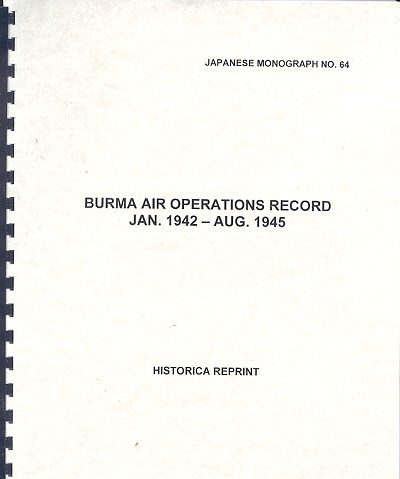 This particular
monograph covers Japanese air operations in Burma during the Second World War.
It was written by two different staff officers of the 5th Air Division, which
was the primary operating control for aviation assets during this period. The
record was taken from the memory of these officers as most official unit
documentation was destroyed by those units just prior to the end of the war. It
is a true loss to all historians that the Japanese in general did a widespread
purge of much of the materials related to their operations during the Pacific
War. As such, very little escaped this mass destruction so we shall never full
know the details of operations by the Japanese during this time
This particular
monograph covers Japanese air operations in Burma during the Second World War.
It was written by two different staff officers of the 5th Air Division, which
was the primary operating control for aviation assets during this period. The
record was taken from the memory of these officers as most official unit
documentation was destroyed by those units just prior to the end of the war. It
is a true loss to all historians that the Japanese in general did a widespread
purge of much of the materials related to their operations during the Pacific
War. As such, very little escaped this mass destruction so we shall never full
know the details of operations by the Japanese during this time
There are two sections to this monograph. The first covers the
period of January 1942 to August 1943 and was written by Masa Tanaka. The second
covers April 1943 to the end of the war in August 1945, and Susumu Ogata is the
author of this section. One thing I found rather interesting was the continual
use of the phrases, 'heavily damaged', 'annihilated', 'completely destroyed',
and so on that permeated the accounts of both of these officers. It seems as if
an operation was either a total success or a dismal failure!
The entire 92 page monograph is written in outline form. To
think that this is an easy read, would not be valid, however, as a student of
military history in general and the Burma theater of operations in particular, I
found it to be most interesting and enlightening. In many cases, the monograph
shows the problems the Japanese had at being spread out so thinly. Having such a
large area of responsibility and having so little in terms of numbers was not
easy for them. It was not helped by constantly having units taken from them for
use in other theaters of operation such as New Guinea and China. One thing that
the Burma front did offer was a rather long period of time when military
operations of any size were nigh impossible thanks to the monsoon season. During
these months, the Japanese pulled back the majority of their air assets to safe
areas in Malaya where they would undergo refit, resupply and training. As the
war progressed, even these safe areas were in jeopardy from Allied attack.
Major Ogata was quite cognizant of the increasing capabilities of Allied air
power and the dwindling effect of his own forces during the later years. It is
quite evident in his assessments.
In all, I enjoyed the ability to get a view-point of what it was
like from the other side. Historical books on the 'other side' are common when
it comes to German perspectives, but sorely lacking in terms of what is
available to us from the Japanese side. This monograph helps to add to that
knowledge base and see the rise and fall of Japanese air power in this
particular area.
It is a publication that no serious Japanese aviation enthusiast
should be without.
Review book courtesy of
Historica,
where you can order your copy of this and many other superb aviation and
modeling books.
If you would like your product reviewed fairly and quickly by a
site that has well over 175,000 visitors a month, please contact
me or see other details in the Note to
Contributors.
 This particular
monograph covers Japanese air operations in Burma during the Second World War.
It was written by two different staff officers of the 5th Air Division, which
was the primary operating control for aviation assets during this period. The
record was taken from the memory of these officers as most official unit
documentation was destroyed by those units just prior to the end of the war. It
is a true loss to all historians that the Japanese in general did a widespread
purge of much of the materials related to their operations during the Pacific
War. As such, very little escaped this mass destruction so we shall never full
know the details of operations by the Japanese during this time
This particular
monograph covers Japanese air operations in Burma during the Second World War.
It was written by two different staff officers of the 5th Air Division, which
was the primary operating control for aviation assets during this period. The
record was taken from the memory of these officers as most official unit
documentation was destroyed by those units just prior to the end of the war. It
is a true loss to all historians that the Japanese in general did a widespread
purge of much of the materials related to their operations during the Pacific
War. As such, very little escaped this mass destruction so we shall never full
know the details of operations by the Japanese during this time